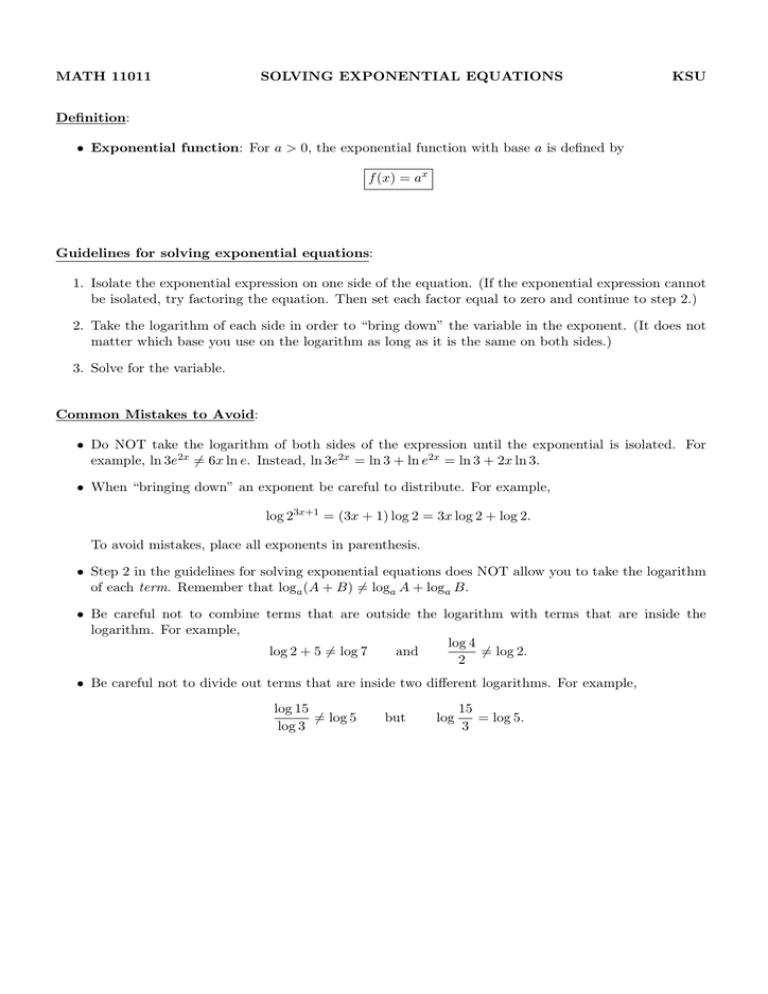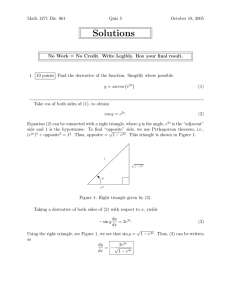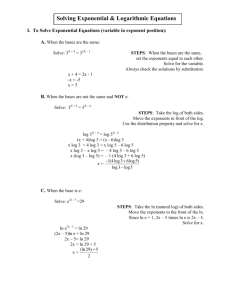Solving exponential equations
advertisement

MATH 11011 SOLVING EXPONENTIAL EQUATIONS KSU Definition: • Exponential function: For a > 0, the exponential function with base a is defined by f (x) = ax Guidelines for solving exponential equations: 1. Isolate the exponential expression on one side of the equation. (If the exponential expression cannot be isolated, try factoring the equation. Then set each factor equal to zero and continue to step 2.) 2. Take the logarithm of each side in order to “bring down” the variable in the exponent. (It does not matter which base you use on the logarithm as long as it is the same on both sides.) 3. Solve for the variable. Common Mistakes to Avoid: • Do NOT take the logarithm of both sides of the expression until the exponential is isolated. For example, ln 3e2x 6= 6x ln e. Instead, ln 3e2x = ln 3 + ln e2x = ln 3 + 2x ln 3. • When “bringing down” an exponent be careful to distribute. For example, log 23x+1 = (3x + 1) log 2 = 3x log 2 + log 2. To avoid mistakes, place all exponents in parenthesis. • Step 2 in the guidelines for solving exponential equations does NOT allow you to take the logarithm of each term. Remember that loga (A + B) 6= loga A + loga B. • Be careful not to combine terms that are outside the logarithm with terms that are inside the logarithm. For example, log 4 log 2 + 5 6= log 7 and 6= log 2. 2 • Be careful not to divide out terms that are inside two different logarithms. For example, log 15 6= log 5 log 3 but log 15 = log 5. 3 Solving exponential equations, page 2 PROBLEMS Solve for x in each of the following equations. (NOTE: there are many different forms of the final answer.) 1. 32x = 7 3. 52x−1 = 4 32x = 7 52x−1 = 4 log 32x = log 7 log 52x−1 = log 4 2x log 3 = log 7 (2x − 1) log 5 = log 4 2x log 3 log 7 = 2 log 3 2 log 3 2x log 5 − log 5 = log 4 2x log 5 = log 4 + log 5 log 7 x= 2 log 3 x= x= log 7 2 log 3 x= log 4 + log 5 2 log 5 log 4 + log 5 2 log 5 4. 3x = 4x+1 2. e4−3x = 2 Here, we will use the natural logarithm. Remember that ln e = 1. 3x = 4x+1 log 3x = log 4x+1 e 4−3x =2 ln e4−3x = ln 2 (4 − 3x) ln e = ln 2 4 − 3x = ln 2 x log 3 = (x + 1) log 4 x log 3 = x log 4 + log 4 x log 3 − x log 4 = log 4 x(log 3 − log 4) = log 4 −3x = −4 + ln 2 x= x= −4 + ln 2 −3 x= 4 − ln 2 3 4 − ln 2 3 x= x= log 4 log 3 − log 4 log 4 log 3 − log 4 Solving exponential equations, page 3 5. 7 + 2x+4 = 12 7. e4x + 7e2x − 18 = 0 Once again, we will factor the expression. 7 + 2x+4 = 12 e4x + 7e2x − 18 = 0 2x+4 = 5 (e2x + 9)(e2x − 2) = 0 log 2x+4 = log 5 (x + 4) log 2 = log 5 Setting each factor equal to zero, we get x log 2 + 4 log 2 = log 5 x log 2 = log 5 − 4 log 2 x= log 5 − 4 log 2 log 2 e2x + 9 = 0 e2x − 2 = 0 e2x 6= −9 e2x = 2 ln e2x = ln 2 log 5 − 4 log 2 x= log 2 2x ln e = ln 2 2x = ln 2 6. e2x − 5ex + 6 = 0 x= Here we cannot isolate the exponential expression. So, we will factor the expression. e2x − 5ex + 6 = 0 (ex − 3)(ex − 2) = 0 Setting each factor equal to zero, we get ex − 3 = 0 ex − 2 = 0 ex = 3 ex = 2 ln ex = ln 3 ln ex = ln 2 x ln e = ln 3 x ln e = ln 2 x = ln 3 x = ln 2 x = ln 3, x = ln 2 x= ln 2 2 ln 2 2 Solving exponential equations, page 4 ¡ ¢ 9. 3 e4x−5 + 2 = 15 8. 4e3x − 8e7x = 0 ¡ ¢ 3 e4x−5 + 2 = 15 4e3x − 8e7x = 0 4e3x (1 − 2e4x ) = 0 e4x−5 + 2 = 5 Setting each factor equal to zero, we get e4x−5 = 3 ln e4x−5 = ln 3 4e3x = 0 e 3x 1 − 2e4x = 0 (4x − 5) ln e = ln 3 −2e4x = −1 6= 0 e4x = x= 1 1 ln 4 2 1 2 4x = 5 + ln 3 ln e4x = ln 1 2 4x ln e = ln 1 2 4x = ln 1 2 x= 4x − 5 = ln 3 1 1 ln 4 2 x= x= 5 + ln 3 4 5 + ln 3 4



